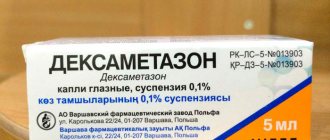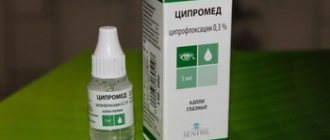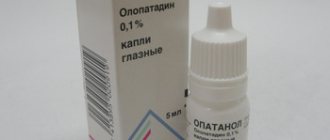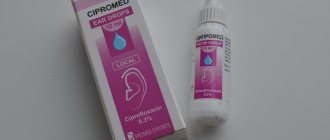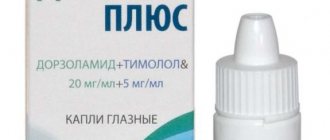What is conjunctivitis?
This term is used by ophthalmologists to refer to the inflammatory process that occurs on the mucous membrane of the eye, the conjunctiva. Depending on the form, the disease proceeds differently, but most often it is characterized by swelling, hyperemia, purulent or mucous membranes.
In this article
- What is conjunctivitis?
- What is conjunctivitis like?
- What can cause the disease?
- Symptoms of conjunctivitis
- How is the disease diagnosed?
- What are Levomycetin drops and why should they be used?
- Properties of chloramphenicol drops
- Rules for using Levomycetin drops
- Does Levomycetin have any contraindications?
- Are there possible side effects from taking Levomycetin? What is important to know?
- Conclusion
discharge from the eyes, watery eyes, burning or itching. Conjunctivitis and its types are today one of the most common diseases among eye pathologies, since the conjunctiva performs a protective function and, due to its anatomical position, is constantly in contact with many external irritants. Normally, it has a smooth, moist surface, pink in color, and blood vessels and meibomian glands are visible through it. When the disease occurs, the mucous membrane becomes cloudy, rough, and scars may form on it.
How to use Levomycetin in the form of injections
Children are administered the drug intramuscularly. Up to one year, twenty-five to thirty milligrams per kilogram of body weight. Children from one year old need to administer the medication intramuscularly at a dose of 50 mg per 1 kg of weight. This dosage is divided into two doses. The medicine should be administered at intervals of twelve hours.
For adult patients, the medication is administered intravenously or intramuscularly. For intramuscular injections, “Levomycetin” from 0.5 to 1 gram is diluted in two to three milliliters of water, then filled into a syringe and injected deep into the muscle.
For intravenous use, a single dose is diluted in ten milliliters of water for injection; Levomycetin should be administered slowly over five minutes.
For eye diseases, the drug is used for injection and drip use, and it is also possible to apply chloramphenicol ointment. During the injection, 0.5 or 0.3 milliliters of a twenty percent solution is administered twice a day.
What can cause the disease?
All ophthalmologists cite neglect of hygiene rules as the primary cause of conjunctivitis. Actually, because of this, the infection appears; it especially affects people with a weak immune system. But the above-mentioned reason is not always the only one.
- Thus, bacterial conjunctivitis, which is caused by household contact, can appear due to staphylococcus, pneumococcus, Pseudomonas aeruginosa or Escherichia coli.
- The causative agent of the viral type of this disease is herpes, chicken pox, measles or acute viral infections: pharyngoconjunctival fever and epidemic keratoconjunctivitis. In children, for example, conjunctivitis caused by a virus manifests itself along with various ENT diseases. In adults, this type of disease is detected together with dry eye syndrome or chronic blepharitis.
- Fungal conjunctivitis is caused by the presence of all kinds of fungi in the human body - mold or yeast.
- The development of allergic conjunctivitis is caused by the body's hypersensitivity to any antigen.
- Non-infectious conjunctivitis can occur when the eyes are irritated by chemical and physical factors.
Symptoms of conjunctivitis
How do you know if you have conjunctivitis? And how quickly should you contact a doctor for help? First of all, it is worth understanding that the clinical picture of the disease depends on the form. However, there are several common signs that characterize most conjunctivitis.
These include:
- swelling and hyperemia of the mucous membrane;
- specific mucous or purulent discharge from the eyes;
- itching;
- burning;
- lacrimation;
- sensation of a foreign body in the eye;
- photophobia;
- blepharospasm.
Often in the morning the patient cannot open his eyes, since the discharge does not allow him to do so. Only a specialist can tell you exactly what type of conjunctivitis you have and how to eliminate it after examination and scraping for laboratory testing. Below we present several signs characteristic of certain types of the disease for a clearer picture.
- Thus, with adenoviral or ulcerative keratitis, visual acuity is significantly reduced, inflammation appears in both eyes with varying degrees of severity.
- In turn, acute conjunctivitis appears suddenly and develops very quickly. A person experiences pain and stinging in the eyes. Against the background of hyperemia, hemorrhages are often observed. This type of illness can last about three weeks.
- As for chronic conjunctivitis, it progresses very slowly. At first, the patient only feels discomfort and feels a foreign body in the eye, then fatigue appears, and the conjunctiva becomes looser.
- Perhaps the most common is viral conjunctivitis, which does not develop independently, but against the background of upper respiratory tract infections and is accompanied by moderate lacrimation and photophobia.
- The disease, caused by allergies, is accompanied by severe itching and pain in the eyes, and sometimes also cough and rhinitis.
- Features of the clinical picture of fungal conjunctivitis are determined by the type of fungus.
- With conjunctivitis caused by the toxic effects of chemicals, severe pain occurs when moving your gaze, blinking, or trying to open or close your eyes.
How is the disease diagnosed?
As mentioned above, it all starts with taking a history and examining the patient. Then, in order to understand which type of disease is in front of the specialist, the doctor conducts an external examination of hyperemia and edema, identifies the presence or absence of discharge from the eye, then takes a smear or scraping and sends it for cytological examination. Ophthalmologists also resort to studying a smear of the conjunctiva and identifying the type of antibodies to the suspected pathogen. After laboratory tests, the picture becomes clear and treatment for conjunctivitis is prescribed. Most often, an integrated approach is used, including the use of drops, ointments, and oral antibacterial medications. Remember that treatment of conjunctivitis requires exceptional hygiene, so during treatment, use only disposable equipment and wash your hands thoroughly. One of the reasons for the occurrence of this disease is failure to comply with basic cleanliness rules.
What are Levomycetin drops and why should they be used?
Among the wide variety of drops that experts prescribe for conjunctivitis, the most popular is Levomycetin.
Why he? This medicine is very effective and is a strong antibiotic that kills bacteria. When used, the inflammatory process disappears, and burning, itching and other unpleasant symptoms are immediately eliminated. These drops can be used by both adults and children. Looking ahead, let's say that people who wear contact lenses should consult a specialist about proper treatment of conjunctivitis with chloramphenicol drops. Typically, optical products are removed and put on again half an hour after instillation.
Description of the drug
Price from 16 rub.
Levomycetin drops are an antimicrobial drug with a wide spectrum of action. It refers to topical antibiotics in ophthalmology. The drug is active against gram-positive and gram-negative bacteria and mycoplasmas, which allows it to be used in the treatment and prevention of eye diseases such as conjunctivitis, blepharitis, keratitis, etc.
Levomycetin eye drops 0.25% are available in sterile bottles with a capacity of 10 ml. The active component of the drops is Chloramphenicol (25 mg in a 1 ml solution).
The excipients of the drug are boric acid and purified water.
Rules for using Levomycetin drops
Typically, eye drops are used every two to three hours. For conjunctivitis, ophthalmologists prescribe one or two drops in each eyelid. With regular use, the frequency of instillation is reduced to 1-2 times a day. Therapy should be continued for about two weeks. Do not be surprised if, when using chloramphenicol drops, you feel a burning sensation - such a reaction is absolutely normal and goes away within a few minutes.
Treatment of conjunctivitis in children with chloramphenicol drops can also cause side effects, so you need to monitor the child’s condition. Ophthalmologists recommend storing drops at a temperature of eight to fifteen degrees in a dry, dark place, out of reach of children. When purchasing drops, check the expiration date.
Features of use in adults
Adults are recommended to instill 1 drop of the drug into the conjunctival sac, slightly retracting the lower eyelid. Frequency of use: 3-4 times a day. The course of treatment is usually 1-2 weeks.
In case of acute purulent conjunctivitis, drops are dripped after preliminary washing of the diseased eye with a solution of Chlorhexidine with a concentration of 0.02 or 0.05%, as well as any other antiseptic - Miramistin, etc. Then 1-2 drops should be instilled every 2-3 hours. As the painful symptoms decrease, Levomycetin should be used 1 drop 3 times a day. As a preventative measure, drops can also be placed into a healthy eye (1 drop 2 times a day).
Expert opinion
Ermolaeva Tatyana Borisovna
Ophthalmologist of the highest category, Candidate of Medical Sciences
Before using the drug, it is recommended to remove contact lenses (if the patient wears them). You can put on lenses no earlier than 20-30 minutes after instilling the drug.
Does Levomycetin have any contraindications?
Like any drug, these drops have a number of contraindications, which must be discussed with the ophthalmologist prescribing them. First of all, people with individual intolerance to the components of Levomycetin and those who have been diagnosed with hypersensitivity are at risk. It is also not recommended to take drops if you have kidney failure or bleeding disorders. Pregnant women and women during the feeding period, children under two years of age and patients with skin diseases are not recommended to use such drops. Especially without consulting a specialist.
Are there possible side effects from taking Levomycetin? What is important to know?
Ophthalmologists say that treatment with chloramphenicol drops on a regular basis can provoke a decrease in platelets and leukocytes in the blood. Consequently, blood clotting disorders and fungal growth are possible. Like any other drug, these drops should be used only as prescribed by a doctor, in dosage and for a certain time.
It is not recommended to use medications that stop bleeding together with Levomycetin, as this process may increase the risk of adverse reactions. Keep in mind that in children, drops can cause digestive dysfunction, increasing the load on the kidneys and liver. If you do not follow the instructions and recommendations, the drops will cause breathing problems and a drop in body temperature in a two-year-old child. When, when treating conjunctivitis with drops, you experience unpleasant symptoms that do not go away within a few minutes, you should stop using the product and consult a specialist.
Pharmacological action and group
The drug has a fairly strong bacteriostatic effect. Levomycetin can inhibit the synthesis of proteins of microorganisms. Levomycetin is active against many bacteria, as well as some strains resistant to Penicillin, Sulfonamides and Streptomycin.
Acid-fast microorganisms, Pseudomonas aeruginosa, clostridia and protozoa are insensitive to the action of the drug. At the same time, the development of resistance to chloramphenicol occurs slowly.
After topical application of Levomycetin drops, high therapeutic concentrations of the substance are observed in the cornea, vitreous body, and iris. The drug does not penetrate the lens of the eye and is excreted mainly in the urine in the form of inactive metabolites.

